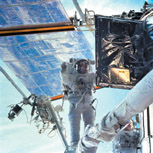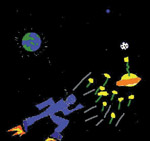 Where
no art has gone
Where
no art has gone
Three
generations of Chicago students met-figuratively, at least-in
an unusual place this March when NASA launched the space shuttle
Columbia to rendezvous with the orbiting Hubble Space Telescope.
 The
meeting took place more than 350 miles above Earth's surface
where a team of astronauts, led by astrophysicist John Grunsfeld,
SM'84, PhD'88, performed repairs to the 12-year-old orbiting
telescope, named after Edwin Hubble, SB'10, PhD'17. Grunsfeld
carried with him a bit of U of C history-the front page of Hubble's
doctoral dissertation-and a bit of its future-a collection of
artwork by third-graders in the U of C's Laboratory Schools.
The
meeting took place more than 350 miles above Earth's surface
where a team of astronauts, led by astrophysicist John Grunsfeld,
SM'84, PhD'88, performed repairs to the 12-year-old orbiting
telescope, named after Edwin Hubble, SB'10, PhD'17. Grunsfeld
carried with him a bit of U of C history-the front page of Hubble's
doctoral dissertation-and a bit of its future-a collection of
artwork by third-graders in the U of C's Laboratory Schools.
The
idea grew out of a chance meeting between Grunsfeld and Michael
Turner, the Bruce V. and Diana M. Rauner distinguished service
professor in astronomy and astrophysics, at a campus conference
last October. Turner's son, Joe, is one of 24 students in his
third-grade class. With three weeks notice, the students drew
pictures, took photos, and wrote stories and poems to be placed
on a CD for Grunsfeld to carry on the flight.
 One
student, Amir Hay, wrote a letter to an alien in case of a close
encounter. "Dear Mr. Alien," Hay wrote, "If you're
Evil, sorry I gave you this note. I was hoping aliens have a
lot of technology. And astronaut Grunsfeld is going to go up
into space and going to deliver this note to you. I was hoping
you guys know how to build robots, because if you do you could
build them for the whole world...." Other students wrote
about flowers on Saturn, time travel, gypsy dancing, and baseball,
to accompany page one of Hubble's slightly more academic contribution,
"Photographic Investigations of Faint Nebulae."
One
student, Amir Hay, wrote a letter to an alien in case of a close
encounter. "Dear Mr. Alien," Hay wrote, "If you're
Evil, sorry I gave you this note. I was hoping aliens have a
lot of technology. And astronaut Grunsfeld is going to go up
into space and going to deliver this note to you. I was hoping
you guys know how to build robots, because if you do you could
build them for the whole world...." Other students wrote
about flowers on Saturn, time travel, gypsy dancing, and baseball,
to accompany page one of Hubble's slightly more academic contribution,
"Photographic Investigations of Faint Nebulae."
The
lighthearted touch of the flight was overshadowed by the seriousness
of its mission-in the 11-day journey, Grunsfeld and his crew
traveled 4 million miles, installed $172 million worth of equipment
on Hubble, and set a new single-flight spacewalk record of nearly
36 hours. The packed schedule was necessary to make repairs
to the telescope's damaged solar wings and replace its central
power controller-a procedure NASA compared to open-heart surgery.
The
telescope, launched in April 1990, could already see farther
than any device ever built and is now ten times more powerful
and is scheduled for eight more years of service.
This
was Grunsfeld's second trip to the satellite he refers to as
"Mr. Hubble." In 1999 he flew a successful emergency
repair mission to fix an ailing control system that had shut
the telescope down completely.
-
C.S.

![]()
 Where
no art has gone
Where
no art has gone The
meeting took place more than 350 miles above Earth's surface
where a team of astronauts, led by astrophysicist John Grunsfeld,
SM'84, PhD'88, performed repairs to the 12-year-old orbiting
telescope, named after Edwin Hubble, SB'10, PhD'17. Grunsfeld
carried with him a bit of U of C history-the front page of Hubble's
doctoral dissertation-and a bit of its future-a collection of
artwork by third-graders in the U of C's Laboratory Schools.
The
meeting took place more than 350 miles above Earth's surface
where a team of astronauts, led by astrophysicist John Grunsfeld,
SM'84, PhD'88, performed repairs to the 12-year-old orbiting
telescope, named after Edwin Hubble, SB'10, PhD'17. Grunsfeld
carried with him a bit of U of C history-the front page of Hubble's
doctoral dissertation-and a bit of its future-a collection of
artwork by third-graders in the U of C's Laboratory Schools. One
student, Amir Hay, wrote a letter to an alien in case of a close
encounter. "Dear Mr. Alien," Hay wrote, "If you're
Evil, sorry I gave you this note. I was hoping aliens have a
lot of technology. And astronaut Grunsfeld is going to go up
into space and going to deliver this note to you. I was hoping
you guys know how to build robots, because if you do you could
build them for the whole world...." Other students wrote
about flowers on Saturn, time travel, gypsy dancing, and baseball,
to accompany page one of Hubble's slightly more academic contribution,
"Photographic Investigations of Faint Nebulae."
One
student, Amir Hay, wrote a letter to an alien in case of a close
encounter. "Dear Mr. Alien," Hay wrote, "If you're
Evil, sorry I gave you this note. I was hoping aliens have a
lot of technology. And astronaut Grunsfeld is going to go up
into space and going to deliver this note to you. I was hoping
you guys know how to build robots, because if you do you could
build them for the whole world...." Other students wrote
about flowers on Saturn, time travel, gypsy dancing, and baseball,
to accompany page one of Hubble's slightly more academic contribution,
"Photographic Investigations of Faint Nebulae."